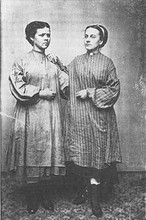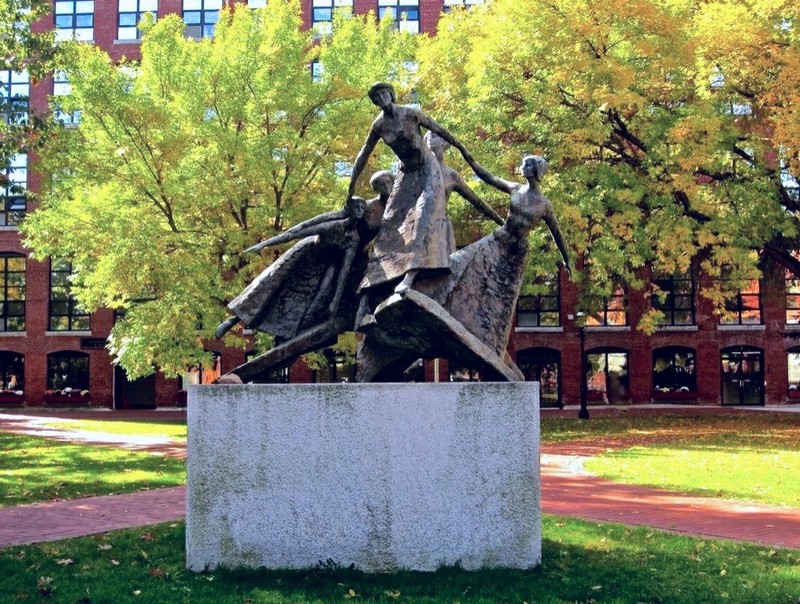Homage to Women, Lowell
Introduction
Text-to-speech Audio
Images
Two of the many Lowell textile workers

This statue honoring the solidarity and dignity of the Lowell "mill girls" was dedicated in 1984.

Backstory and Context
Text-to-speech Audio
The City of Lowell was, from its very inception, an industrial town. Founded in the 1820s as a planned town devoted to the goal of creating a textile manufacturing center, Lowell flourished thanks to its proximity to Boston and its location around a well-known set of rapids along the Merrimack River. Lowell made the perfect location for the Boston Manufacturing Company to construct a major mill, and it was the “Boston Associates” of the Boston Manufacturing Company who founded the town, naming it after Francis Cabot Lowell, the most influential founder of the BMC.
Over the years, Lowell, Massachusetts, became one of the most important cities in the fueling of the American Industrial Revolution, attracting a large pool of laborers, largely Irish immigrants and women from New England rural communities. The famous mills were primarily staffed by the young, single women who came to the town, who became known as the “Mill Girls.”
The 1830s to 1850s would prove to be perhaps the most radical and revolutionary decade for Lowell. As industry grew in Lowell, working conditions declined severely and the Mill Girls who had come to work in Lowell, often to help their families, rallied and organized in order to challenge the terrible conditions and unfair pay they were receiving. At the time, girls working in mills often earned less than half the pay that their male counterparts would receive, in addition to being required to work in terrible workplace conditions.
While the Mill Girls suffered, mill owners’ profits soared, and the revelation of this information to the people of Massachusetts led to some local support when the Mill Girls decided to strike. The first strike occurred in 1834, following the textile mills’ implementation of a significant wage reduction. Organizing outside of work, the Mill Girls decided upon a “turn-out” strike. The Mill Girls tactic involved withdrawing all their money from the local banks, which resulted in a panic.
Unfortunately, the mill owners and managers waited out the strike, and local support was too little and too late. Those involved in the turn-out had to choose to either return to their families or accept slashed pay. In days following the unsuccessful strike, representatives and managers of the mills engaged in slander of the labor movement, targeting the fact that the strike had been organized by women.
Numerous individuals in the employ of the mill companies portrayed the strike as indicative of a lack of femininity on the part of the Mill Girls. The attempt to slander the women of the mills was only one part in a campaign of further exploitation of their labor.
It was two years later that the Lowell Mill Girls decided to strike again. An economic depression of severe magnitude struck the country in the late 1830s, and this resulted in multiple rent increases in the boarding houses. The mills collectively chose to cover the cost of the first rent hike, but not subsequent hikes, meaning that Mill Girls living in basic housing which was owned by investors in and owners of the mills were told they would have to cover increased rent out of their own pay.
Life in the boarding houses was not luxurious. There were stringent rules such as curfews, limitations on visitors (especially visitors of the opposite sex,) and religious requirements as well. Some women shared their rooms with half a dozen other women. A rent hike on such conditions was understandably unacceptable.
The 1836 strike was preceded by the creation of the Factory Girls’ Association, which then organized the strike. Similar to the 1834 strike, the 1836 strike was a turn-out in which the Association organized its members to withdraw money en masse from the local banks. During the strike, a number of young women spoke out in public—a first for the city of Lowell—bringing the attention of locals, both positively and negatively, to the strike.
The 1836 strike swung into a major movement, with over 1,500 Mill Girls joining. In addition, the organization of publicity for the strike resulted in much of the Lowell community supporting the strike, especially since there was a case for the violation of labor contracts by the mills’ management. This time, the strike was successful, resulting in the Board of Directors of the mills backing off on rent increases entirely.
The success of the 1836 strike generated momentum for further labor organization in Lowell. In 1845, the first women workers’ union was formed, known as the Lowell Female Labor Reform Association. It grew remarkably quickly, maintaining its all-women staff and leadership.
To this day, the name of the city of Lowell is inseparable from the ideals of women’s empowerment and labor rights, with many monuments, such as the “Homage to Women,” being found within the borders of the city.
The Homage itself is located in the Lowell National Historical Park along the Merrimack River. Created by artist Mico Kaufman in 1984, the bronze sculpture depicts a group of women helping one another climb to the tip of a precipice. Sometime around the time of the dedication of the piece, Mico Kaufman explored the spirit of what he hoped to capture in his piece:
“Although this sculpture was inspired by the ‘mill girls’ of the Industrial Revolution, it easily identifies with the struggles and aspirations of working women everywhere. The figures represent women of different races and celebrate the contributions made by women throughout time. Women all over the world have one trait in common: they work, they work hard, and their work is unheralded.”
Lowell proved to be one of the most influential locations in the future of labor rights in the United States, and its profound recognition even more than a century after the source of its fame is testament to the impact the Mill Girls had on the history of labor in the Northeast United States.
The Homage sums up a foundational piece of Lowell’s history into a visually striking image that brings the echoes of peaceful resistance to the eyes and heart of modern-day travelers.
Sources
Dublin, Thomas. Labor History: Women, Work, and Protest in the Early Lowell Mills: The Oppressing Hand of Avarice Would Enslave Us. Vol. 16. Abingdon, Oxfordshire, UK. Carfax Publishing LTD. Located at the online archive at https://web.archive.org/web/20090227063040/http://invention.smithsonian.org/centerpieces/whole_cloth....
